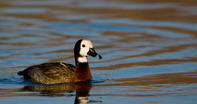
Name
White-faced duck (Dendrocygna viduata)Appearance
The adult male white-faced duck’s front half of the head and throat is white. The rest of its head and neck are black with white patches on the underside of the neck.
The lower neck and wing shoulders are chestnut and the flanks are barred black on white. The other underparts, underside of the wings, the rump and tail are black. Their back and scapulars are an olive-brown edged with golden buff. The white-faced duck has brown eyes, a black bill and the feet, toes, and webs are blue with black markings.
The female is similar but the front of the head and neck are tinged with a rusty colour. Although it has the long neck and long legs of other tree ducks, it does not spend much time perched in trees but prefers sand banks. It behaves more like a goose or swan than a typical duck.
White-Faced Duck Diet
The white-faced duck eats underwater tubers and seeds of aquatic plants, molluscs, small aquatic animals and invertebrates such as aquatic insects. They usually obtain their food by diving.White-Faced Duck Breeding
Nests are built with leaves on the ground, in marshes and also in hollow trees. Mutual preening plays an important part in the formation of pairs and the maintenance of this bond. Clutches consist of 6-12 eggs and both partners incubate the eggs for 28-30 days. The ducklings are often hidden in aquatic vegetation by the parents.White-Faced Duck Behaviour
The white-faced duck is a highly social species with flocks often numbering in the hundreds. Most foraging activity takes place at night, so there is a lot of nocturnal flying. During the day the ducks roost near water, preening themselves and others.
They are fast swimmers but do not dive, except for food. The White-faced duck is a noisy bird with a distinctive high-pitched, multisyllabic whistle which sound very un-duck like. The male and female calls differ slightly and may be a bonding mechanism. There is a good deal of nomadic movement in relation to variations in water and food availability.
They are often found in association with the fulvous duck (Dendrocygna bicolour). Its attractive appearance makes it a popular bird in waterfowl collections.
 SouthAfrica.co.za provides informative, educational content on many South African bird species that orthologists and bird-watchers would enj...
SouthAfrica.co.za provides informative, educational content on many South African bird species that orthologists and bird-watchers would enj...